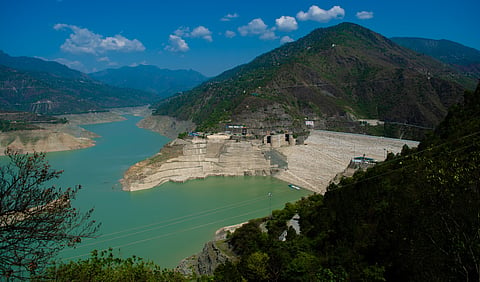

The ICIMOD report reveals that the Hindu Kush Himalayas (HKH) region is tapping only 6.1% of its vast renewable energy potential, with hydropower significantly underutilized.
Despite a potential of 882 GW, only 49% is harnessed.
The report calls for regional cooperation and investment in infrastructure to boost clean energy use and mitigate climate risks.
Despite holding immense renewables potential, clean energy makes up a very low (6.1 per cent) proportion of total primary energy supply (TPES) in the countries of the Hindu Kush Himalayas (HKH), with hydropower singled out as being ‘hugely underexploited’, according to a new report.
The report from the eight-nation regional intergovernmental body, the International Centre for Integrated Mountain Development (ICIMOD), was launched on September 5, during the Asia-Pacific Clean Energy Week in Bangkok.
It highlights that of 882 Gigawatt (GW) total hydropower potential identified in Afghanistan, Bhutan, Bangladesh, China, India, Myanmar, Nepal and Pakistan; the vast majority of that potential (635 GW) is from the waters of the trans-boundary rivers of the HKH region.
Just 49 per cent of this potential is currently tapped. Non-hydro clean energy potential (solar and wind) in the HKH region, meanwhile, stands at 3 Terawatts.
While the total combined renewable energy targets of the countries of the HKH amount to 1.7 Terawatts (as per their Nationally Determined Contributions), the renewable energy potential within the HKH region alone is over >3.5 Terawatts.
While Bhutan and Nepal generate 100 per cent of their electricity from renewables, fossil fuels overwhelmingly dominate other HKH countries’ electricity generation: representing 98 per cent in Bangladesh, 77 per cent in India, 76 per cent in Pakistan’s, 67 per cent in China, and 51 per cent in Myanmar.
Meanwhile, biofuels and waste make up an ‘alarmingly high’ proportion of total primary energy supply (TPES) in four HKH countries — contributing two-thirds of Nepal’s; half of Myanmar’s; and one quarter of Bhutan and Pakistan’s energy supply. This reflects rural communities’ continued reliance on traditional materials (wood, crop residues, livestock dung) for cooking and heating, despite the impacts on air quality and human health.
The new study, Together we have more power: status, challenges, and the potential for regional renewable energy cooperation in the Hindu Kush Himalaya, examines existing energy sources, the share of renewable sources in the overall energy mix, analyses climatic and non-climatic risks to the energy sector and explores potential for renewable energy cooperation.
The study warns that climate change is significantly impacting the energy sector, particularly hydropower production, through increased water variability, extreme weather events, and infrastructure damage. Changing hydrological regimes resulting in streamflow variations and seasonal shifts affect output, it finds.
Glacial lake outburst floods and other extreme events pose ‘major risks’ to existing and planned hydropower projects — with close to two-thirds of current and planned hydropower vulnerable to potential glacier floods alone. The analysis stresses the need to integrate disaster risk mitigation strategies into renewables projects.
It emphasises that while multipurpose dams play a role in flood moderation and water management, they alone cannot address the growing risks of mega-floods, water wastage, or mismanagement. The document highlights the importance of exploring ‘dams equivalents’—a suite of modern technological, structural, and institutional solutions that can deliver similar benefits while avoiding the downsides of large reservoirs. Dams’ equivalents measures include updating irrigation systems to reduce water wastage, on-farm water-efficient and climate-resilient practices, urban water storage and the adoption of solar and wind.
The report flags a number of barriers to progress on renewables in the region, running from high capital costs, limited public finance, and the difficulty of attracting private investment; the potentially far-reaching consequences of renewables development for local communities, ecosystems, and health; lack of technology and experience, land availability, knowledge on operations and maintenance and investment in research and development; and the need for new policy and regulatory frameworks that factor in air and water pollution.
“We have extraordinary renewables potential within our region, as well as in India and China, two of the world’s pioneers in clean energy,” said coordinating lead author, Avishek Malla, launching the report in Bangkok. “Building on this amazing competitive advantage that Asia now holds in renewables represents a tremendous opportunity to turbocharge green economic growth, while lifting people out of poverty, and meeting our ambitious emissions-reductions targets.
“It is crucial that we think beyond trade for us to truly seize the opportunity of renewables holds for our region, however: we need investment in infrastructure, and a massive uptick in south-south skills and technology exchange, leveraging existing platforms including the South Asian Association for Regional Cooperation’s Energy Centre and the Bay of Bengal Initiative for Multi-Sectoral Technical and Economic Cooperation energy ministers conference. We also need international financial institutes to play a catalytic role in building this infrastructure to meet the needs of today but also safeguard the wellbeing of future generations.”
Regional cooperation on energy must be designed to capture the full spectrum of benefits, the report finds — from renewable energy trade, disaster risk reduction, and enhanced agricultural productivity to industrial development, improved water navigation, and strengthened agricultural trade. Such cooperation also enables the transfer of renewable energy technologies and knowledge, fosters green growth and job creation, and supports countries in achieving their national and global commitments.